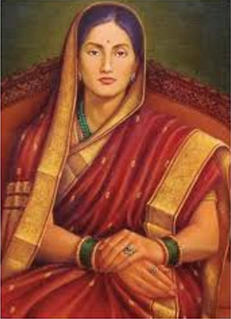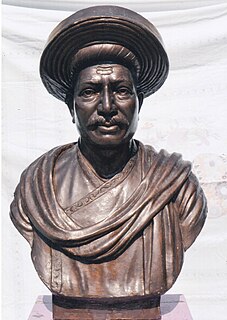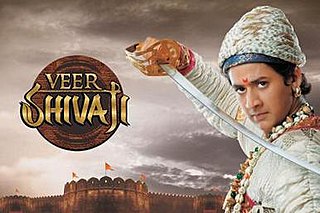
Shivaji Bhonsale I, also referred to as Chhatrapati Shivaji, was an Indian ruler and a member of the Bhonsle Maratha clan. Shivaji carved out an enclave from the declining Adilshahi sultanate of Bijapur that formed the genesis of the Maratha Empire. In 1674, he was formally crowned the Chhatrapati (emperor) of his realm at Raigad.
Chhatrapati is a royal title from the Indian subcontinent that was mainly used by the Marathas. It is often taken to be the equivalent of emperor. The word ‘Chhatrapati’ is a Sanskrit language compound word of chhatra and pati (master/lord/ruler) which is considered as a symbolic representation of the protector of people. The parasol was considered a symbol of absolute, or even universal, sovereignty and consecrated kingship, and has been used by monarchies outside of the Indian subcontinent, as well. The title indicates a person who is a sovereign ruler over other princes, and not a vassal. In contrast, the Indian titles of Maharaja or Raja, Yuvraj, Rajkumar or Kumar, and Senapati, reflect a range of European equivalent meanings, from King, Crown Prince, and Prince, to Duke, Count, or Lord. Shivaji adopted 'Chhatrapati' since other titles were bestowed by other lieges and paramount rulers, like the Adilshahis or Mughals.
The Bhonsle are a prominent group within the Maratha clan system. They claim descent from the Sisodia Rajputs but were likely Kunbi tiller-plainsmen.

Shahu Bhosale I was the fifth Chhatrapati of the Maratha Empire created by his grandfather, Shivaji Maharaj. Born in the Bhonsle family, he was the son of Sambhaji Maharaj, Shivaji Maharaj's eldest son and successor. Shahu, as a child, was taken prisoner along with his mother in 1689 by Mughal sardar, Zulfikar Khan Nusrat Jang after the Battle of Raigarh. After the death of Aurangzeb in 1707, leading Mughal courtiers released Shahu with a force of fifty men, thinking that a friendly Maratha leader would be a useful ally. At that time he fought a brief war with his aunt Tarabai in an internecine conflict to gain the Maratha throne in 1708.
Hambirrao Mohite was the chief military commander of Chhatrapati Shivaji's army. An able military general, he executed several campaigns for Shivaji Raje and later served under Sambhaji Maharaj.

Kolaba Fort is an old fortified maritime base in Alibaug, Konkan, India. It is situated in the sea at a distance of 1–2 km from the shores of Alibag, 35 km south of Mumbai, in the Konkan region of Maharashtra, India. It is a popular tourist destination and a protected monument.

Saibai Bhosale was the first wife and chief consort of Shivaji, the founder of the Maratha Empire. She was the mother of her husband's successor and the second Chhatrapati, Sambhaji.

Ramchandra Neelkanth Bawadekar (1650–1716), also known as Ramchandra Pant Amatya, served on the Council of 8 as the Finance Minister (Amatya) to Emperor (Chhatrapati) Shivaji dating from 1674 to 1680. He then served as the Imperial Regent to four later emperors, namely Sambhaji, Rajaram, Shivaji II and Sambhaji II. He authored the Adnyapatra, a famous code of civil and military administration, and is renowned as one of the greatest civil administrators, diplomats and military strategists of the Maratha Empire.
Jaoli principality was a Jagir of Maratha Morè (clan) which is located in the western part of the present day Maharashtra state. Jaoli was seen as a strategically important by Shivaji Maharaj as it is surrounded by dense forest with 13 forts.
Shiledar was a term used for a soldier's position in India's Maratha Empire (1630–1818), particularly during the reign of Shivaji. The word shiledar means "a soldier who possesses his own sword and horse for taking active part in combat/war".

Purandar Fort is known as the birthplace of Chhatrapati Sambhaji Maharaj, the son of Chhatrapati Shivaji Maharaj. The fort of Purandhar stands at 4,472 ft above the sea level in the Western Ghats, 50 km to the southeast of Pune.

The Lal Mahal of Pune is one of the most famous monuments located in Pune, India, where Shivaji, founder of the Maratha Empire spent his childhood.

Mohite is a Maratha clan.
Mahadik is a surname mainly found in Maharashtra and surrounding states of India. The surname is mainly found among Maratha (caste). Original kingdom: Bagalkot in Karnataka
Sawant is a Hindu religion surname of a Kshatriya Maratha clan, found mainly in the state of Maharashtra and neighbouring states in India. Origin Sawants are considered as Royal Knights of the Shilahara Dynasty who Ruled Konkan and were ruled by kings such as Khem Raje Sawant and Fond Raje Sawant. Sawant is the surname of a Maratha clan among the 96 royal clans of the Kshatriya Cast. Sawant possess commonly used Maratha honorific titles such as Sardar, Raje and Patil and they were active, having a historic presence in Maharashtra, Karnataka( predominantly in Karwar region ), Baroda, Nagpur, Satara, Sangli, Kolhapur, Goa and other Maratha-dominated regions of India. Sawant (Savant) word is derived from samant ("feudatory"). However, Maratha Sawants are from different clans such as Chandravanshi Sawant, Sawant-Bhosale (Sisodiya descendant), Sawant - Salunkhe, Sawant-Patel (Parmar descendant). Sawant was also a high rank feudal title given to Salunkhe-Patankar clan by Bahamani sultans. The Sawant branches are related to the kings and sardars of the Maratha clans. Bhirawade is one of the village who known for "Sawant Patel's" Armor. Titles The Sawant clan enjoyed the numerous feudal titles like Patil, Deshmukh, Desai, Sardesai, Naik, Sarpatil, Sardar, Sarkar under different Administrative powers like the Shilahars, the Bahamanis, the Mughals, the Marathas and the Britishers etc.

Akkalkot State during the British Raj, was a Maratha princely state ruled by the Bhonsle dynasty. The non-salute state came under the Deccan States Agency and was bordered by Hyderabad State and the Bombay Presidency.

Veer Shivaji is an Indian historical drama series that aired on Colors TV. The show focuses on the life of Chhatrapati Shivaji, the 17th century founder of the Maratha Empire. It premiered on 2 September 2011 and was produced by Contiloe Telefilms, who had earlier created the historical drama Jhansi Ki Rani on Zee TV. Due to the instant success and popularity and with TRP of more than 2.60, the show timing were extended to five days a week from 3 October 2011.
The following list includes a brief about the titles of nobility or orders of chivalry used by the Marathas of India and by the Marathis/Konkanis in general.
![]() Fixed
Fixed








